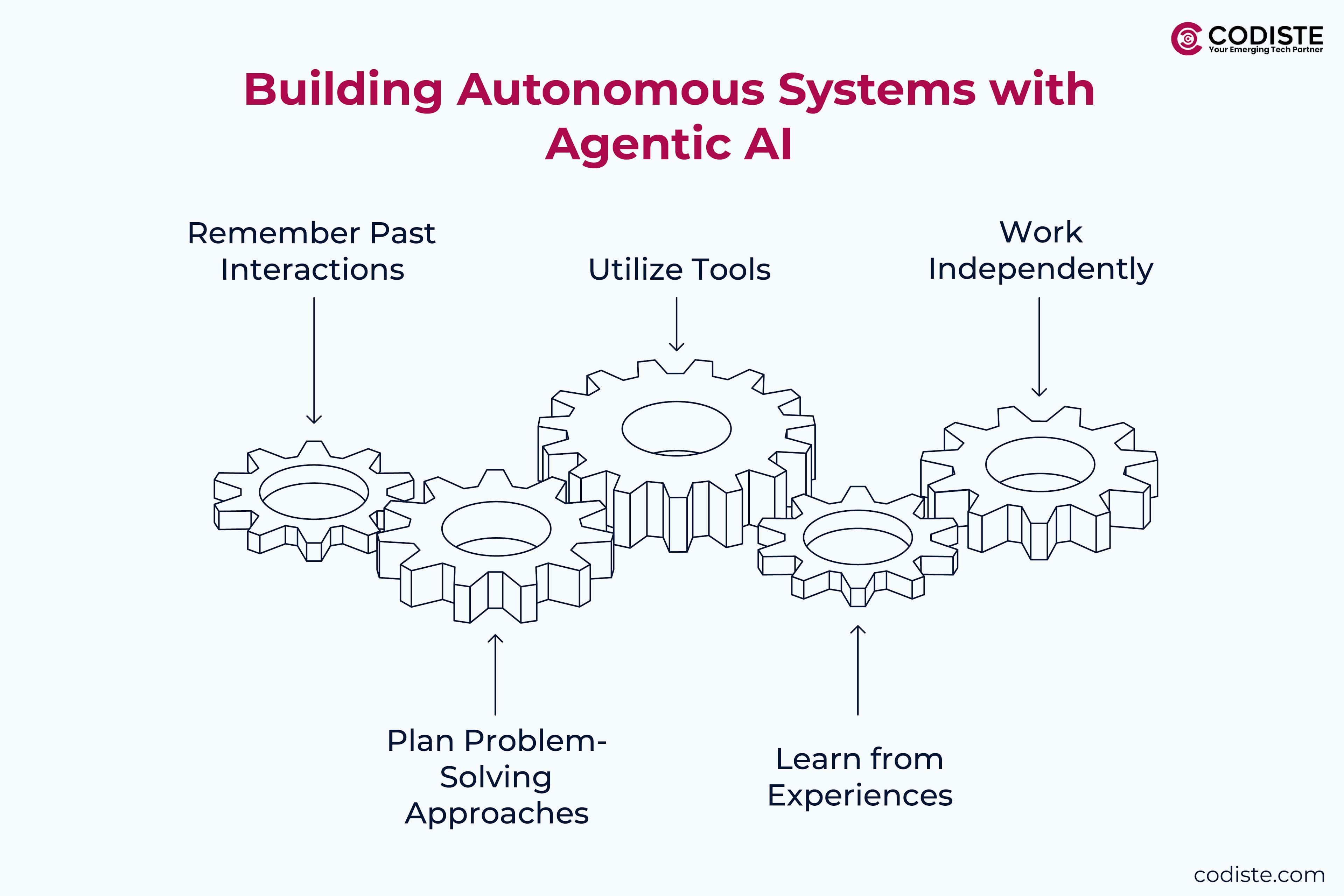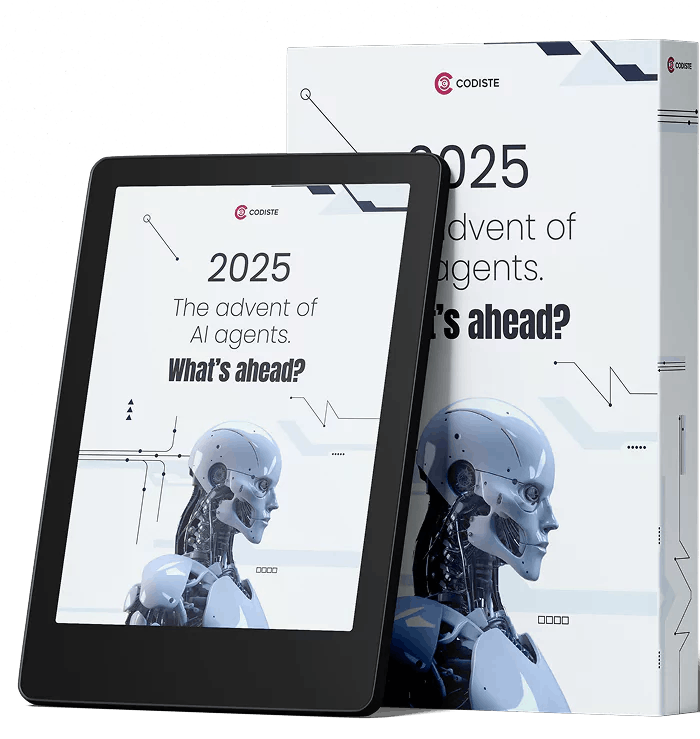
,
With the advent of Large Language Models (LLMs) like ChatGPT and Claude, the AI field is going through a significant transition. These sophisticated models are used further for autonomous systems development that can carry out difficult tasks with little human oversight, beyond simple text generators.
These "agentic LLMs" can comprehend context, solve problems, and make choices on their own, in contrast to conventional LLMs that mostly produce text in response to input prompts. They can now communicate with users more naturally and efficiently thanks to developments in deep learning, natural language processing, and reinforcement learning.
We shall explore the inner workings of these agentic LLMs in this autonomous AI guide, looking at their architecture and functionality. We'll also look at the uses of agentic AI in a range of sectors, from content production to customer support automation and more.
Come along as we explore the possibilities and ramifications of this fascinating development in agentic AI implementation and imagine a time where agentic LLMs are essential to fostering efficiency and innovation.
How Do You Build Autonomous Systems Using Agentic AI?
Traditional LLM agent development is mostly done to produce text in response to cues. This is further enhanced by agentic LLMs, which have additional features that enable them to:
- Remember Important Information from Past Interactions
Agentic LLMs can retain contextual information from previous interactions, which enables them to deliver more personalised and pertinent responses that are tailored to the user's preferences and history.
- Plan Approaches to Solving Complex Problems
These models are capable of analysing complex challenges and developing strategic solutions to resolve them. They can establish logical solutions and pathways for resolution by deconstructing issues into manageable steps.

- Use Tools Like Search Engines, Calculators, or Databases
To improve their capabilities and knowledge, agentic LLMs can integrate with external tools and resources, such as search engines or databases. This enables them to retrieve real-time information and execute specialised duties, such as data analysis or calculations.
- Learn from Successes and Failures
Analysing the results of their actions, agentic LLMs can enhance and adjust their performance over time. The efficacy of their future interactions and problem-solving scenarios is improved as a result of the refinement of their strategies developed through this learning process.
- Work Independently with Reduced Human Guidance
The purpose of these models is to operate autonomously, necessitating minimal human intervention to complete duties. The ability to leverage their capabilities for a variety of applications is facilitated by this independence, which streamlines workflows and enhances efficiency.
Consider the difference between a personal assistant who can manage information, conduct topic research, and finish work over time (agentic LLM) and a skilled writer who can create content on demand (conventional LLM).
Read more:
The Complete Generative AI Handbook for Business Leaders
Building Autonomous Systems with Agentic LLMs: A Practical Guide
How to Implement AI Agents in Your Small Business
The Essential KPIs to Track AI Agent Deployment Success
How can you Design Reliable Autonomous AI Systems with Agentic AI?
Memory
Memory is an essential element of autonomous systems development, as it enables agentic AI to interact meaningfully with users and function effectively. In the same way that humans depend on memory to navigate their daily lives, AI agents employ memory to remember user preferences, maintain context, and expand upon previous interactions. This capability improves their efficacy and enables more personalised experiences. Short-term memory and long-term memory are the two primary categories of memory components in autonomous systems.
Short-Term Memory
Often called working memory, short-term memory is crucial for handling the current context of interactions. It enables AI agents to:
- Maintain Current Context
Short-term memory allows the agent to respond appropriately and coherently by storing information pertinent to the current task or conversation. In a customer service situation, for example, it facilitates a seamless discussion flow by assisting the agent in recalling the user's most recent questions and answers. - Store Recent Interactions
The agent can refer to the most recent exchanges during the conversation, as this memory type captures them. This is especially advantageous in conversational AI, where user gratification is contingent upon the preservation of continuity. - Facilitate Immediate Decision-Making
Short-term memory supports quick responses and actions by retaining temporary data required for immediate operations, thereby increasing the agent's efficacy in real-time scenarios.
Nevertheless, short-term memory has capacity and endurance constraints, and it normally resets after the job is completed or when the context changes. This requires a strong long-term memory system to supplement it.
Long-Term Memory
The repository for knowledge that has been accumulated over time is long-term memory, which enables AI agents to learn and adapt. It is further subdivided into numerous subtypes:
- Episodic Memory
Similar to human memories, this type enables agents to recollect particular past experiences. For instance, an AI customer support agent can recall prior interactions with a user, thereby customising responses to their preferences and history. This fosters user loyalty and creates a more personalised experience. - Semantic Memory
Semantic memory is a repository of factual knowledge and general information about the world that is not dependent on specific events. It facilitates the comprehension of concepts and relationships, thereby enabling agents to provide pertinent information and accurate responses to enquiries. For example, the utility of an AI assistant is increased by its ability to retrieve information on a variety of subjects. - Procedural Memory
The abilities and procedures that an agent has acquired over time are included in this category. It enables AI systems to perform operations automatically without requiring human reasoning at every stage. An AI that has mastered workflow optimisation, for instance, can carry out intricate action sequences with ease, enhancing overall performance.
Memory Integration
For autonomous systems to operate well, short-term and long-term memory must be integrated. This integration makes it possible for:
- Seamless Transition
Agents can draw on prior experiences while preserving context in ongoing interactions when information can move seamlessly between short-term and long-term memory. - Pattern Recognition
Agents are able to improve their learning and modify their tactics by identifying trends in their experiences. - Knowledge Consolidation
Effective information organisation and retrieval guarantee that agents may swiftly obtain pertinent knowledge, enhancing their capacity for responsiveness and decision-making.
Memory helps AI learn, adapt, and engage with users. These systems may manage short-term and long-term memory to personalise experiences, optimise speed, and change over time, boosting their utility across applications.
Reasoning and Planning
AI agents can make intelligent judgments and complete tasks with reasoning and planning. Structured reasoning improves decision-making in modern AI agents, unlike basic input-output systems. Autonomous systems' thinking and planning are covered in this section.
Structured Reasoning Approaches
Effective agents must think critically before acting. The reasoning process consists of several fundamental steps:
- Consideration of Known Information
AI agents start by examining current situation data. Understand context, user preferences, and pertinent data that may affect decision-making. The agent can build strong reasoning by analysing its knowledge. - Exploration of Possible Approaches
After obtaining data, the agent considers several approaches to the problem. This involves brainstorming alternatives and assessing their viability given context and resources. The agent can find the best solution by exploring numerous options. - Creation of a Plan of Action
The agent creates a detailed plan after considering several strategies. This plan provides a defined framework for the agent's goal-achieving steps. A clear plan helps agents handle complex tasks. - Adjustment of the Plan Based on New Information
While executing its plan, the agent watches for new information and environmental changes. The agent can alter its strategy in real time to comply with the changing context. Feedback and new data help the agent improve results.
Recent Advances in Reasoning and Planning
AI improvements have increased autonomous system thinking and planning. Conceptualising reasoning phases with chain-of-thought prompting improves multi-step task performance. Self-reflection lets agents evaluate their reasoning and make better decisions.
Neural network-based neuro-symbolic approaches are also growing. Agents reason better in complex real-world circumstances using both methodologies.
AI agents can think critically, adapt to changing conditions, and complete tasks perfectly by thinking and planning. Ordained reasoning can help these agents make better decisions, improving their reliability and effectiveness in many applications.
Tool Usage
Powerful autonomous systems can do impossible things by interacting with multiple tools. By integrating Large Language Models, these tools help AI agents acquire real-time information and behave successfully. The importance of autonomous system tools is discussed in this section.
- Web Browsers and Search Engines
Web browsers and search engines allow autonomous systems to access the internet's vast knowledge base and conduct extensive research from several sources. This lets AI agents deliver accurate, current answers by merging comprehensive internet solutions.
- Calculators and Data Analysis Tools
Calculators and data analysis tools in autonomous systems accurately compute and analyse complex data. These capabilities allow AI agents to do difficult mathematical operations for finance and engineering and uncover data trends and patterns to improve evidence-based decision-making.
- Calendars and Scheduling Systems
Automatic systems with calendars and scheduling apps efficiently manage time-related chores. AI assistants schedule and invite meetings, simplifying organisation. They also enhance productivity by instantly informing users of deadlines and events.
- Email and Communication Platforms
Autonomous systems linked to communication platforms streamline email exchanges and workflows. These AI bots reduce user effort and provide rapid assistance by handling messages autonomously and in real time across various channels.
- Databases and Knowledge Bases
Structured information repositories improve database-accessing autonomous system performance. AI agents improve response accuracy and learning, and adaptability by employing targeted queries to quickly retrieve data and keeping well-organised knowledge bases for future use.
Using these strategies, autonomous systems can do numerous jobs more efficiently. Tool utilisation increases agents' autonomy and ability to provide timely and accurate information, affecting how people use technology. New autonomous system construction tools and LLMs enable imaginative applications in numerous industries.
AI agents to analyze huge amounts of data to get your own data forecasts.
Popular Ways to Design Autonomous Systems
Several successful design patterns have arisen, including:
The Manager-Worker Approach
The Manager-Worker method is a strategy framework for planning how large language models (LLMs)-powered autonomous systems should operate. One LLM serves as a manager in this approach, and other LLMs with specialised skills take care of particular duties. A project manager's coordination of team members with varying specialities to accomplish a shared objective is similar to this hierarchical organisation.
- Role of the Manager LLM
The workflow manager LLM oversees everything. Divide complicated activities into smaller, more doable pieces. This decomposition helps the manager establish each subtask's needs and the best LLM to complete it. The manager maintains efficiency and effectiveness by assigning tasks based on worker skills and capabilities.
- Coordination of Specialized Worker LLMs
Each LLM is optimised for data analysis, content creation, or information retrieval. Since each worker may focus on their strengths, this specialisation helps the system solve complex problems. One customer care representative may handle product feature questions while another handles technical concerns. Problem-solving is simplified by this division of labour.
- Integration of Results
After the worker LLMs finish their tasks, the manager LLM combines their outputs. The workers' components must match the goal through this synthesis process. The manager checks outputs for consistency and quality, making adjustments as needed to provide a polished and accurate result.
- Enhanced Decision-Making
The Manager-Worker method promotes task execution and decision-making. By monitoring the entire workflow, the manager LLM may allocate resources, prioritise tasks, and make real-time adjustments. This monitoring reduces errors and ensures output satisfies requirements.
In conclusion, the Manager-Worker approach is effective for constructing autonomous systems with agentic LLMs. Through specialised worker agents and central manager oversight, this system improves efficiency, accuracy, and adaptability in complicated activities. This collaborative paradigm will help design more advanced autonomous systems as AI technology advances.
The Think-Act-Observe Loop
The Think-Act-Observe Loop is a basic structure that directs autonomous agent workflow behaviour. Agents can handle complicated tasks with clarity and debugging ease thanks to this ongoing loop. To support continuous learning and adaptation, the loop's three main phases—Think, Act, and Observe—are repeated in a cycle.
Think
The agent assesses the current circumstance and plans its next course of action during the "Think" phase. This includes:
- Assessing Context
The collected data, which includes user inputs, environmental conditions, and past encounters, is analysed by the agent. The agent gains a better understanding of the current situation thanks to this assessment. - Generating Options
The agent develops possible courses of action based on the evaluation. The agent can investigate many approaches and choose the best one through this brainstorming process. - Decision-Making
The agent evaluates the benefits and drawbacks of each choice, taking into account variables including efficacy, efficiency, and possible results. Making well-informed decisions requires this critical thinking process.
Act
The agent proceeds to the "Act" phase, when it carries out its selected plan, after deciding on the optimal course of action.
It includes:
- Utilising Tools
To complete its task, the agent may use a variety of resources or tools. Depending on the task, it could, for instance, send an email, access a database, or carry out a calculation. - Providing Information
The agent may occasionally have to convey information to users or other systems. Depending on the action taken, this could entail creating answers, revising documentation, or starting procedures. - Executing the Plan
Effectively putting its choice into practice, the agent acts. To advance the process and accomplish the intended result, this step is essential.
Observe
Following the action, the agent moves into the "Observe" phase, during which it keeps an eye on the outcomes of its actions. This comprises:
- Collecting Feedback
In order to determine whether the intended outcomes were attained, the agent collects data on the results of its actions. Changes in the environment, system outputs, or user responses can all provide this feedback. - Evaluating Effectiveness
To ascertain whether its action was successful, the agent examines the feedback. This assessment aids in determining what was successful and what would require enhancement. - Learning and Adapting
The agent can modify its future tactics and behaviours in light of the observations. The agent's capacity to manage comparable jobs in the future is improved by this learning process, which is essential for ongoing development.
The Think-Act-Observe Loop is a structured, step-by-step strategy to help autonomous agents handle complicated tasks. Cycle through these phases to adapt to changing situations, improve decision-making, and increase performance. This iterative structure streamlines task execution, debugging, and optimisation, making it vital for robust autonomous systems.
The Team of Specialists
Multi-role AI agents work together to tackle complicated issues in autonomous systems using the Team of Specialists technique. Human teams use their distinct skills to achieve a goal, like this model. Combining specialised agents' skills improves task execution efficiency, accuracy, and adaptability.
Roles of Specialised AI Agents
- Researcher Agent
The researcher agent searches databases, web resources, and other information repositories to gather relevant data for the task while understanding its nuances and relevance.
- Analyst Agent
After the researcher agent gathers the data, the analyst agent organises and interprets it to find patterns, trends, and insights needed for decision-making. They also evaluate the data's quality and reliability to ensure that the conclusions drawn are based on accurate and relevant data.
- Writer Agent
After the analysis, the writer agent writes reports, summaries, or other documentation to effectively communicate the research and analysis results in a clear, well-structured, and audience-specific manner to improve understanding and engagement.
Collaborative Dynamics
For specialised agents to complete difficult jobs, cooperation is essential. Important facets of their collaboration include:
- Task Delegation
The manager agent assigns assignments according to skill and coordinates the work of the writer, analyser, and researcher agents. This maximises performance by ensuring that each agent concentrates on its areas of strength. - Information Sharing
Agents exchange information and insights along the process. For example, the writer might ask for clarity on findings to improve the final product, while the analyst might advise the researcher on useful kinds. - Iterative Refinement
The group can make adjustments to their work in response to criticism and fresh data. This process of ongoing improvement guarantees that the finished work satisfies exacting requirements for relevance and quality.
The Team of Specialists model pooled AI agents' strengths to address challenging issues. This method improves autonomous systems' efficiency, accuracy, and flexibility by emulating human cooperation dynamics, making them better at complex tasks across domains.
What if we say, you can now delegate business tasks to AI agents and optimize business automation.
Real-World Applications
These autonomous systems are already being used in real-world situations:
Research Assistants
These agents are capable of searching the scientific literature, summarising findings, identifying connections between studies, and even developing new research concepts. They're especially useful in fields with a large amount of published research.
Personal Productivity Assistants
Autonomous agent workflow can help with email management, meeting scheduling, document summarisation, and report preparation. They can learn individual preferences over time, making them increasingly useful personal assistants.
Customer Service
Advanced agents can respond to sophisticated consumer inquiries by accessing product information, order histories, and corporate policies. They can manage whole discussions, escalating only the most exceptional instances to human representatives.
Content Creation
Autonomous systems may research themes, outline material, compose articles, and even tailor them to specific audiences. This enables content development faster and more scalable while retaining quality.
Important Considerations
To construct autonomous systems that are responsible, significant attention must be paid to:
Safety and Control
Autonomous doesn't mean uncontrolled. Well-designed systems include:
- Clear boundaries on what the agent can and cannot do
- Human approval for significant actions
- Detailed logging of all activities
- Easy override mechanisms
Transparency
Users should be aware of the system's capabilities, decision-making process, and stored data. This fosters trust and makes teamwork more successful.
Reliability
Robust error management and the capacity to identify when they are overstepping their bounds are essential for autonomous systems. The best systems know when to seek human assistance.
The Way Forward
Even though they are still in their development phase, autonomous AI systems are developing quickly. Current patterns indicate that we will soon witness:
- More specialised agents are designed for specific industries and tasks
- Better coordination between multiple agents
- Increased ability to learn from experience
- Deeper integration with existing business systems
Instead of trying to completely replace human judgment, the most effective implementations will be those that carefully blend AI capabilities with human oversight, developing systems that increase human productivity.
Getting Started
Organizations that are interested in exploring autonomous systems need to understand:
- Start with clear use cases where automation would provide significant value
- Begin with semi-autonomous systems that maintain substantial human oversight
- Focus on augmentation rather than replacement of human workers
- Build in feedback mechanisms that help the system improve over time
Conclusion
An intriguing development in AI is represented by LLM agent development. Through the integration of strong language skills with memory, reasoning, and tool usage, these agentic AI systems are able to do ever-more-complex tasks with increasing autonomy. The groundwork for autonomous systems development is all about creating useful frameworks that can provide tangible benefits in a variety of applications which are still in their nascent phase, despite the fact that there are still difficulties.
Success comes from carefully planning systems that integrate AI's advantages with human supervision, forming alliances that are more powerful than either AI or humans acting alone, rather than from developing completely autonomous AI.
With this autonomous AI guide one thing is certain, agentic AI will take on the automated workflows with a strom and provide results that are unexpected and effective. I you find this take interesting and would like to know more about the amazing world of autonomous agents you can subscribe with Codiste newsletter and get the most out of the latest technological developments. Subscribe Now.





